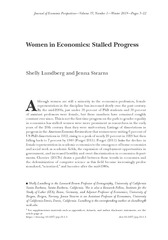Women in economics: Stalled progress
Peer reviewed, Journal article
Published version

Åpne
Permanent lenke
https://hdl.handle.net/1956/21694Utgivelsesdato
2019Metadata
Vis full innførselSamlinger
- Department of Economics [287]
Originalversjon
https://doi.org/10.1257/jep.33.1.3Sammendrag
Women are still a minority in the economics profession. By the mid-2000s, just under 35 percent of PhD students and 30 percent of assistant professors were female, and these numbers have remained roughly constant ever since. Over the past two decades, women's progress in academic economics has slowed, with virtually no improvement in the female share of junior faculty or graduate students in decades. Little consensus has emerged as to why, though there has been a renewal of widespread interest in the status and future of women in economics and of the barriers they face to professional success. In this paper, we first document trends in the gender composition of academic economists over the past 25 years, the extent to which these trends encompass the most elite departments, and how women's representation across fields of study within economics has changed. We then review the recent literature on other dimensions of women's relative position in the discipline, including research productivity and income, and assess evidence on the barriers that female economists face in publishing, promotion, and tenure. While differences in preferences and constraints may directly affect the relative productivity of men and women, productivity gaps do not fully explain the gender disparity in promotion rates in economics. Furthermore, the progress of women has stalled relative to that in other disciplines in the past two decades. We propose that differential assessment of men and women is one important factor in explaining this stalled progress, reflected in gendered institutional policies and apparent implicit bias in promotion and tenure processes.